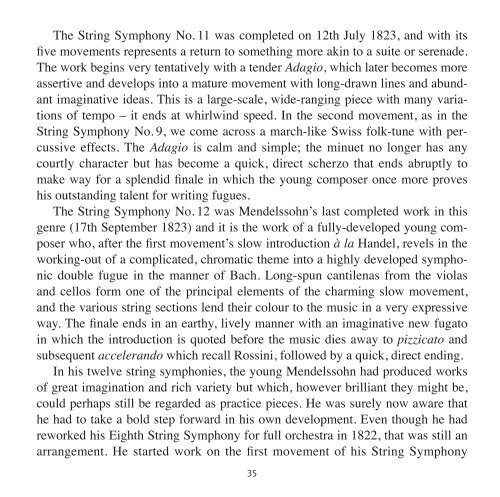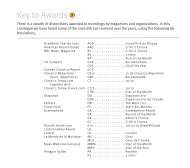MENDELSSOHN - Bis
MENDELSSOHN - Bis
MENDELSSOHN - Bis
Create successful ePaper yourself
Turn your PDF publications into a flip-book with our unique Google optimized e-Paper software.
The String Symphony No. 11 was completed on 12th July 1823, and with its<br />
five move ments represents a return to something more akin to a suite or sere nade.<br />
The work begins very tentatively with a tender Adagio, which later be comes more<br />
assert ive and develops into a mature movement with long-drawn lines and abund -<br />
ant imag in ative ideas. This is a large-scale, wide-ranging piece with many varia -<br />
tions of tempo – it ends at whirlwind speed. In the second movement, as in the<br />
String Sym phony No. 9, we come across a march-like Swiss folk-tune with per -<br />
cus sive effects. The Ada gio is calm and simple; the minuet no longer has any<br />
courtly character but has be come a quick, direct scherzo that ends abruptly to<br />
make way for a splendid finale in which the young composer once more proves<br />
his outstanding talent for writ ing fugues.<br />
The String Symphony No. 12 was Mendelssohn’s last completed work in this<br />
genre (17th September 1823) and it is the work of a fully-developed young com -<br />
poser who, after the first movement’s slow introduction à la Handel, revels in the<br />
working-out of a complicated, chromatic theme into a highly developed sym pho -<br />
nic double fugue in the manner of Bach. Long-spun cantilenas from the violas<br />
and cellos form one of the principal elements of the charming slow move ment,<br />
and the various string sections lend their colour to the music in a very expressive<br />
way. The finale ends in an earthy, lively manner with an imaginative new fugato<br />
in which the introduction is quoted before the music dies away to pizzicato and<br />
sub sequent accelerando which recall Rossini, followed by a quick, direct ending.<br />
In his twelve string symphonies, the young Mendelssohn had produced works<br />
of great imagination and rich variety but which, however brilliant they might be,<br />
could perhaps still be regarded as practice pieces. He was surely now aware that<br />
he had to take a bold step forward in his own development. Even though he had<br />
re worked his Eighth String Symphony for full orchestra in 1822, that was still an<br />
arrange ment. He started work on the first movement of his String Sym phony<br />
35








